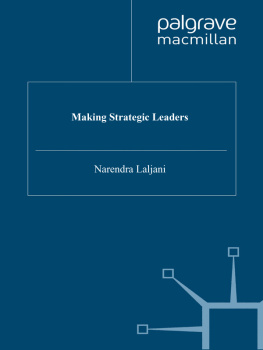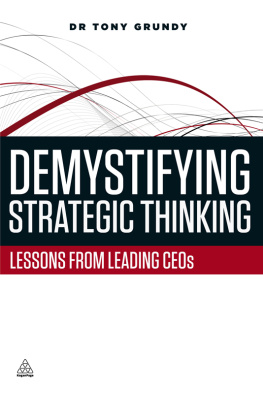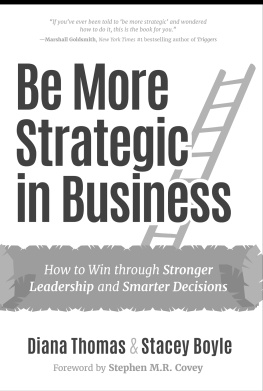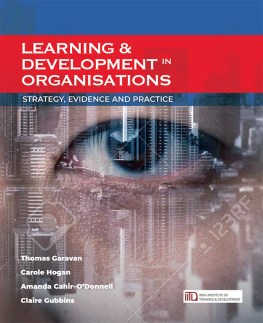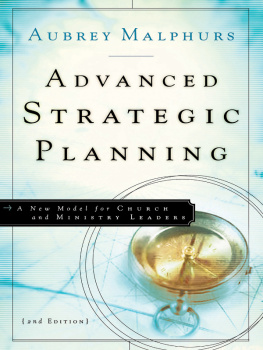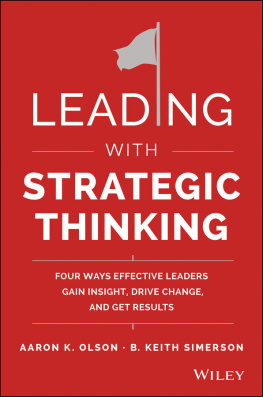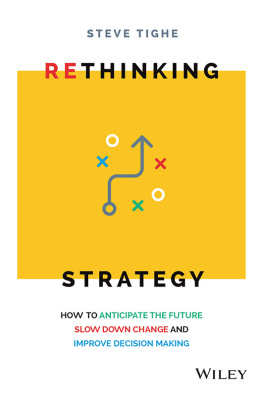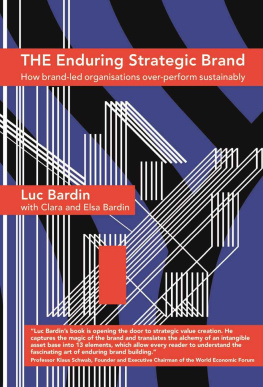Narendra Laljani - Making Strategic Leaders
Here you can read online Narendra Laljani - Making Strategic Leaders full text of the book (entire story) in english for free. Download pdf and epub, get meaning, cover and reviews about this ebook. year: 2009, publisher: Palgrave Macmillan, genre: Business. Description of the work, (preface) as well as reviews are available. Best literature library LitArk.com created for fans of good reading and offers a wide selection of genres:
Romance novel
Science fiction
Adventure
Detective
Science
History
Home and family
Prose
Art
Politics
Computer
Non-fiction
Religion
Business
Children
Humor
Choose a favorite category and find really read worthwhile books. Enjoy immersion in the world of imagination, feel the emotions of the characters or learn something new for yourself, make an fascinating discovery.
- Book:Making Strategic Leaders
- Author:
- Publisher:Palgrave Macmillan
- Genre:
- Year:2009
- Rating:3 / 5
- Favourites:Add to favourites
- Your mark:
- 60
- 1
- 2
- 3
- 4
- 5
Making Strategic Leaders: summary, description and annotation
We offer to read an annotation, description, summary or preface (depends on what the author of the book "Making Strategic Leaders" wrote himself). If you haven't found the necessary information about the book — write in the comments, we will try to find it.
Making Strategic Leaders — read online for free the complete book (whole text) full work
Below is the text of the book, divided by pages. System saving the place of the last page read, allows you to conveniently read the book "Making Strategic Leaders" online for free, without having to search again every time where you left off. Put a bookmark, and you can go to the page where you finished reading at any time.
Font size:
Interval:
Bookmark:
Narendra Laljani


Narendra Laljani 2009
All rights reserved. No reproduction, copy or transmission of this publication may be made without written permission.
No portion of this publication may be reproduced, copied or transmitted save with written permission or in accordance with the provisions of the Copyright, Designs and Patents Act 1988, or under the terms of any licence permitting limited copying issued by the Copyright Licensing Agency, Saffron House, 610 Kirby Street, London EC1N 8TS.
Any person who does any unauthorized act in relation to this publication may be liable to criminal prosecution and civil claims for damages.
The author has asserted his right to be identified as the author of this work in accordance with the Copyright, Designs and Patents Act 1988.
First published 2009 by
PALGRAVE MACMILLAN
Palgrave Macmillan in the UK is an imprint of Macmillan Publishers Limited, registered in England, company number 785998, of Houndmills, Basingstoke, Hampshire RG21 6XS.
Palgrave Macmillan in the US is a division of St Martins Press LLC,
175 Fifth Avenue, New York, NY 10010.
Palgrave Macmillan is the global academic imprint of the above companies and has companies and representatives throughout the world.
Palgrave and Macmillan are registered trademarks in the United States, the United Kingdom, Europe and other countries
ISBN-13: 978-0-230-57749-7 hardback
This book is printed on paper suitable for recycling and made from fully managed and sustained forest sources. Logging, pulping and manufacturing processes are expected to conform to the environmental regulations of the country of origin.
A catalogue record for this book is available from the British Library.
A catalogue record for this book is available from the Library of Congress.
10 9 8 7 6 5 4 3 2 1
18 17 16 15 14 13 12 11 10 09
Printed and bound in Great Britain by
CPI Antony Rowe, Chippenham and Eastbourne
For
Mangho and Shanta Laljani
and with an eye to the future,
for Milan
Figures
Tables
A large number of people gave generously with their time and ideas while I was developing the thinking that underpins this work. I would particularly like to express my gratitude to Prof. Cliff Bowman, Dr. Catherine Bailey, and Dr. Veronique Ambrosini all at Cranfield University for their guidance and support.
I am also thankful to Prof. Joe Nellis, Prof. Mark Jenkins, and Prof. Kim James at Cranfield, Prof. Veronica Hope-Hailey at City University, Dr. Eddie Blass at the University of Hertfordshire, and Prof. Henry Mintzberg at McGill University, for their encouragement and always insightful comments.
At Ashridge, I am indebted to Bob Stilliard, Fiona Dent, Kai Peters, James Moncrieff, Steve Watson, Albert Zandvoort, Phil Hodgson, Stefan Wills, Elaine Stedman, Gabriele Silver, Peter Silver, and Sarah Graves for their support and assistance.
I would also like to acknowledge the contribution of the various interviewees at different stages of the research who offered their candid reflections on their roles, the leadership challenges they faced, and their formative development experiences. For obvious reasons, their identities have been anonymized.
This study also builds on the work of numerous distinguished scholars. Every effort has been made to cite them appropriately and secure copyright permission where required. If any inadvertent omissions have occurred I will be happy to remedy these at the earliest opportunity.
On a more personal note, this book evolved over several years. The start of the research that informs it coincided with the arrival of my son, Milan, and frequently competed with his needs and interests. This balancing act which I hope Milan will agree some day that I got mostly right would not have been possible without the support of my wife, Karin. Thank you.
Following 15 years in managerial roles in industry, I took to an academic and consulting career in 1995. In this incarnation, my early work was anchored in the teaching of strategy, and strategic analysis in particular. Both the content and style of my teaching were greatly influenced by my own educational experience as an MBA student in the late 1970s. I had been taught to believe that managers planned, organized, directed, and controlled: a seemingly elegant and linear process. Curiously, leadership did not get much attention in that curriculum.
At Ashridge, my audiences were mainly made up of executives on short management development programmes. Although they had a bias for action and practice, they appeared to find analytical frameworks seductive. I often wondered if I was colluding with their needs for simplicity in a complex world. At the back of my mind was the Bill Gates question, posed to me by an MBA student: are you suggesting that Bill Gates did a strategic analysis of the software industry when he was building Microsoft?
For some time, then, I nursed a sense of unease about my professional practice. Perhaps there was more to strategy than analysis, more to leader effectiveness than a vision and self-awareness, and more to development than a high-impact classroom experience. I perceived a gap between the reality of the world of the strategic leader and common leadership development interventions, and as I inquired further I realized that I was not alone. This gap became the primary motivation for this research.
This study unites the domains of strategy and leadership, and offers an integrated perspective on the dimensions, development, and deployment of strategic leader capability. The research was carried out in three phases. In the first, a conceptual framework was developed based on four key dimensions of capability: judgement, the strategic conversation, contextual mastery, and behavioural complexity. In the second phase, empirical findings from in-depth qualitative interviews with individuals in strategic leadership roles corroborated and enriched the framework; highlighted the importance of informal learning; and emphasized the role of mentors and stretch assignments as formative development processes. In addition, critical reflection, through either informal or formal processes, was found to play an important sense-making and developmental role. In the third phase, action research involving two formal leader development interventions was undertaken with the objective of developing strategic leader capability while deliberately managing the influential development processes identified.
The results indicated that while strategic leader capability can be learned, and that key development processes can be simulated with varying degrees of success, positive performance outcomes also require high self-efficacy. Based on these findings, this study presents a model which links together strategic leadership capability, major development processes, self-efficacy, context, and performance outcomes. These insights into strategic leader performance and development have significant practical implications for individuals, organizations, and the leader development industry. I believe the research also raises numerous interesting questions that merit further inquiry.
This book documents a journey of discovery based on three thematically linked research projects. While the details of these are reported in the following chapters, the background on the issue or problem that motivated this study, an overview of the research questions, and the accompanying research methodology are discussed here.
Font size:
Interval:
Bookmark:
Similar books «Making Strategic Leaders»
Look at similar books to Making Strategic Leaders. We have selected literature similar in name and meaning in the hope of providing readers with more options to find new, interesting, not yet read works.
Discussion, reviews of the book Making Strategic Leaders and just readers' own opinions. Leave your comments, write what you think about the work, its meaning or the main characters. Specify what exactly you liked and what you didn't like, and why you think so.

